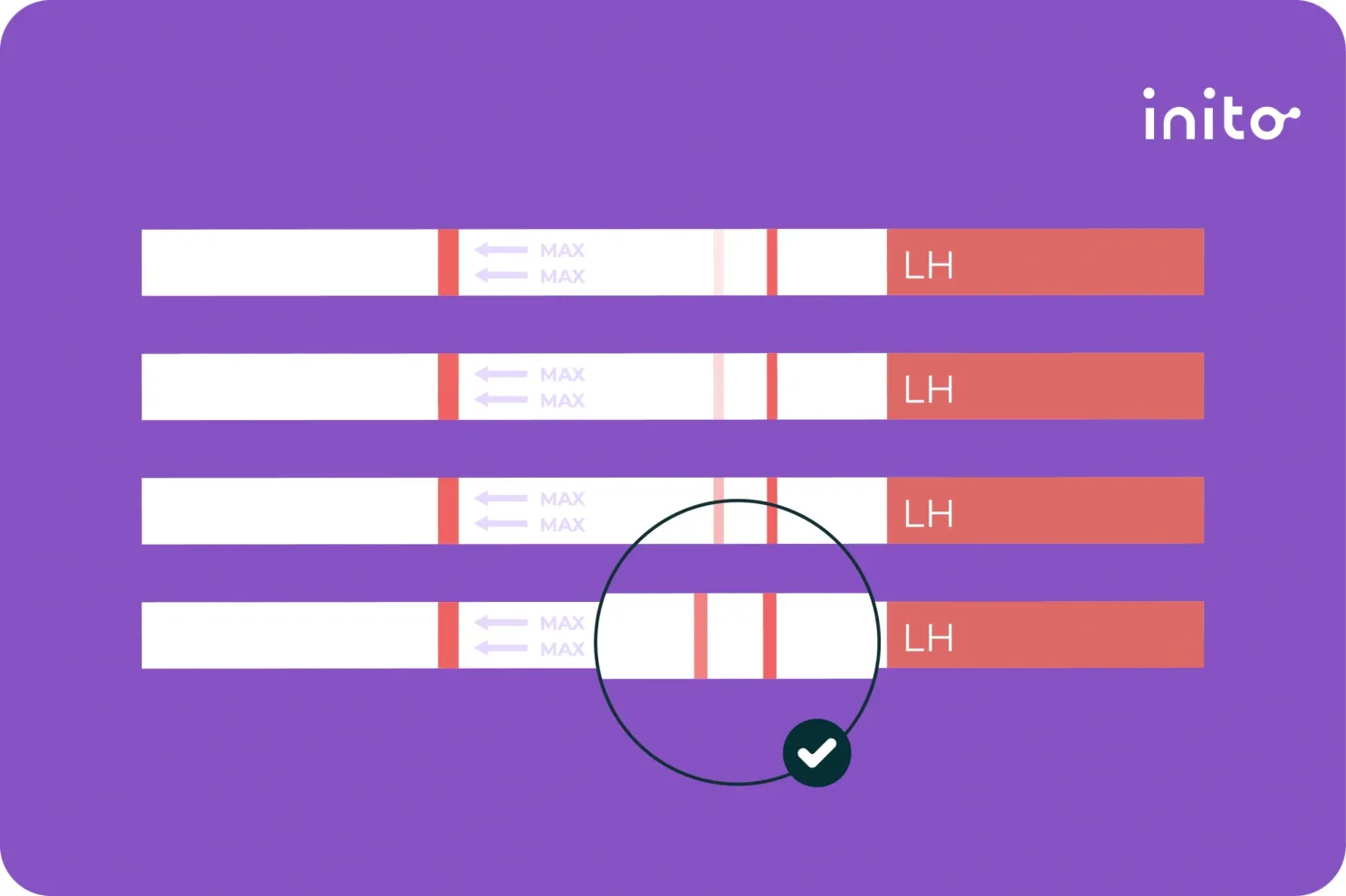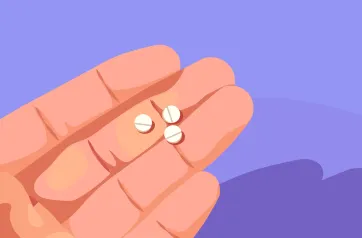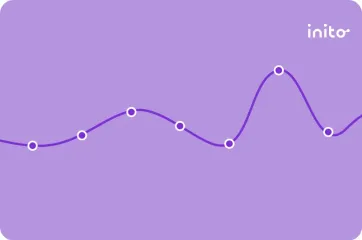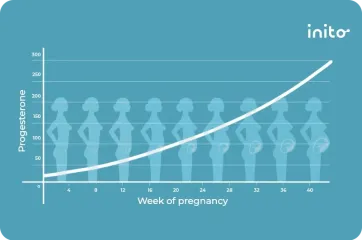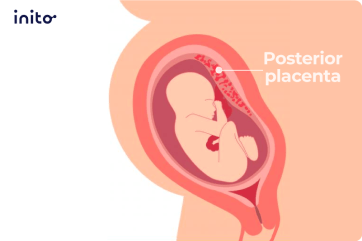Content table
Feeling confused because your ovulation testing isn’t progressing normally? We understand. Ovulation tests are handy when you’re trying to get pregnant. But interpreting these tests can be tricky.
Ovulation tests show a positive result when Luteinizing Hormone (LH) surges. The trouble is LH levels and surges vary a lot from person to person. And because of this, not all ovulation testing progression looks the same.
That’s why we’re here to clear up the confusion. Keep reading to learn what a ‘normal’ ovulation test progression looks like.
Takeaways
- Ovulation tests detect Luteinizing Hormone (LH) in your urine. This hormone surges 24-36 hours before ovulation occurs.
- On ovulation predictor kits, the test line darkens depending on how much LH is in your urine. When the test line is as dark or darker than the control line, it’s considered a positive result.
- LH levels and surge patterns vary, which affects how your ovulation testing progresses. You could have a single, plateau, double, biphasic, or multiple surge pattern.
- If your test doesn’t turn positive you could have had a rapid surge, tested too early, or your LH levels may be lower than average. Or you may have had an anovulatory cycle.
- It’s best to start testing four days before you expect to ovulate. That way, you’re less likely to miss it.
- You have the highest chance of getting pregnant the day before ovulation. So once you get a positive result, head to the bedroom!
- Inito tracks your LH, FSH, estrogen, and PdG. This gives you a complete picture of your fertile window and confirms you ovulated.
How do ovulation tests work?
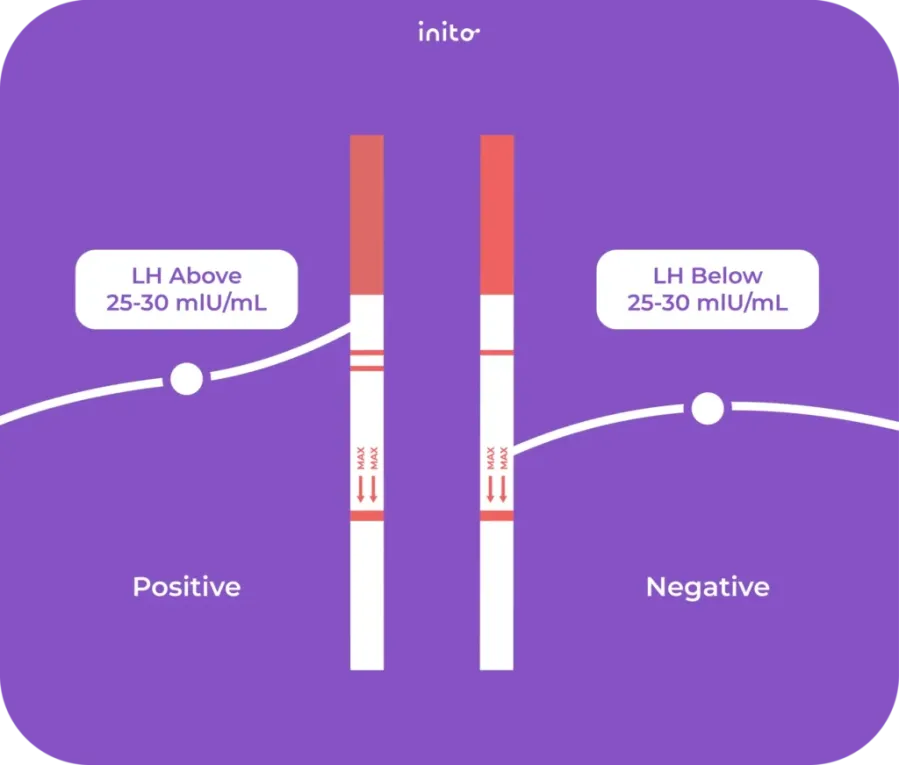
Ovulation Predictor Kits (OPKs), also known as ovulation tests work a lot like pregnancy tests.
Ovulation test strips come with two lines: a control line and a test line. The control line tells you the test is working, while the test line gives your results.
As mentioned, ovulation tests check how much Luteinizing Hormone (LH) is in your urine. FYI, LH is the fertility hormone that triggers ovulation. So when LH rises, it’s prime baby-making time!
When an ovulation test detects LH, the test line darkens. The darker the line, the more LH was detected.
A positive ovulation test strip is when the test line appears as dark or darker than the control line. This means your LH levels are surging and you can expect to ovulate soon.
If a faint line appears on an ovulation test strip, it means some LH was detected. But not enough to suggest a surge. If this happens, keep testing every day until you get a positive result.
Know more: What Does a Faint Line On an Ovulation Test Mean?
When does ovulation occur after a positive test?
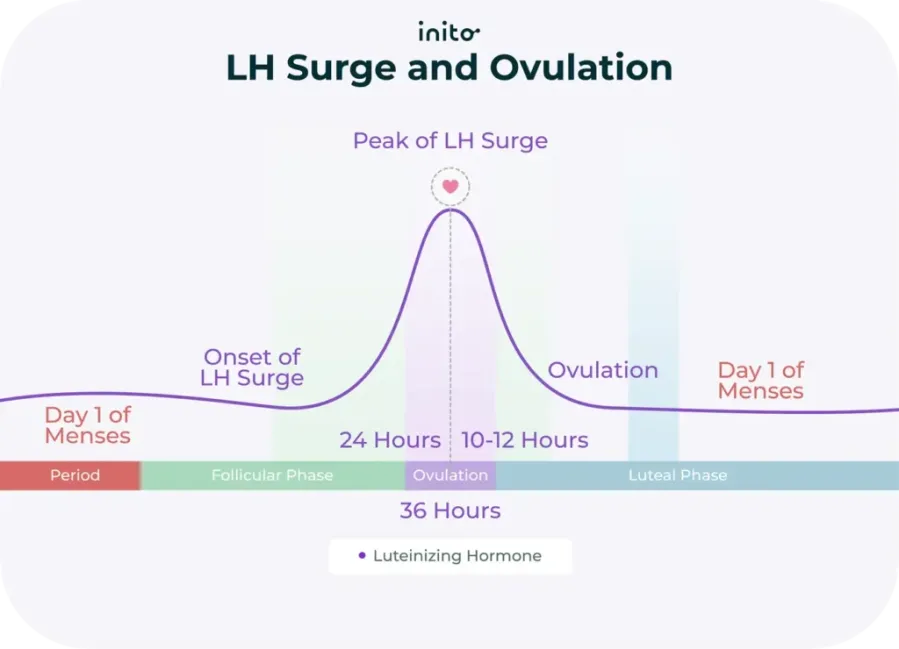
Ovulation occurs roughly 24-36 hours after a positive ovulation test. So, if you get a positive result and are trying to get pregnant, it’s a good day to get busy.
Sex the day before ovulation offers the best chance of conception. Meaning, you’re at peak fertility the day your LH surges.
Know more: Chances of Getting Pregnant on Ovulation Day
Interpreting ovulation tests can be a bit of a guesswork. So let’s look at how your ovulation tests may progress.
Know your chances of Ovulation!
Take our ovulation quiz to understand how your hormone patterns and
lifestyle factors may affect your chances of ovulating

Understanding ovulation testing progression
How ovulation test results progress varies depending on your LH surge pattern. So if your tests don’t look the same as others, don’t worry.
Like your menstrual cycle, each woman’s LH surge pattern is unique. Some women have rapid LH surges that peak in less than a day. Others have a more gradual rise that stays high for days.
To understand better, let’s look at different types of LH surges and how they may show up on an OPK vs. Inito.
Single surge
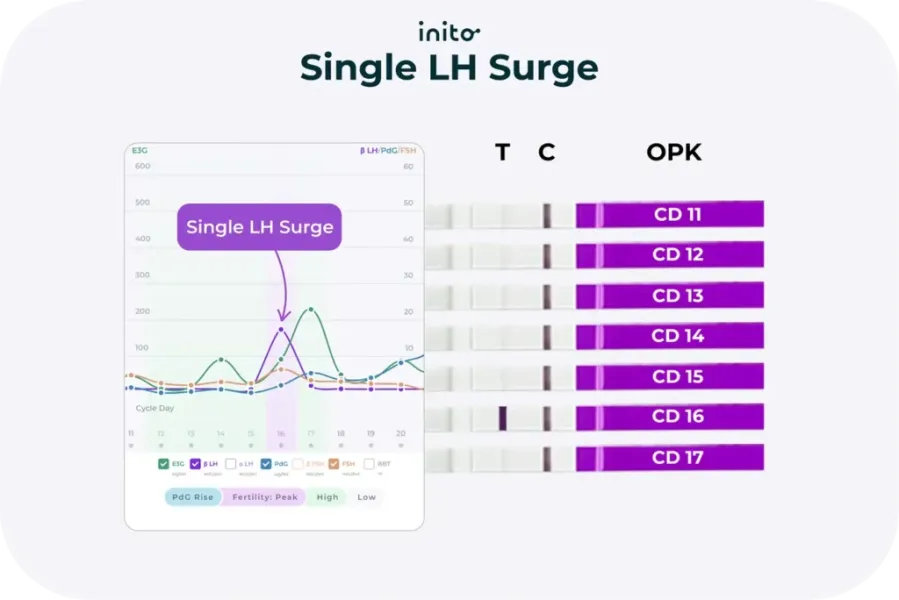
This surge pattern is a single, steep rise in LH that peaks within 24 hours. It’s the most common pattern and happens in roughly 48% of cycles.
OPK:
On an ovulation test, a single LH surge would look like a positive test result in one day. As you can see in the results above, LH peaked on cycle day 16.
The days leading up to the positive result may show a faint line–or no line at all. Once the surge passes, the test line will get lighter too.
Keep in mind that OPKs base results on average thresholds. If your LH levels fall below the threshold, you could get a false negative. And if your LH levels are naturally high, you could get a false positive.
Also, a positive OPK only predicts ovulation–it doesn’t confirm it. PdG (a urine metabolite of progesterone) is what confirms ovulation.
Inito
Inito displays hormone charts with your actual LH values. When your LH surges, you get a digital message that says, “Peak Fertility.” Easy peasy.
Plateau surge
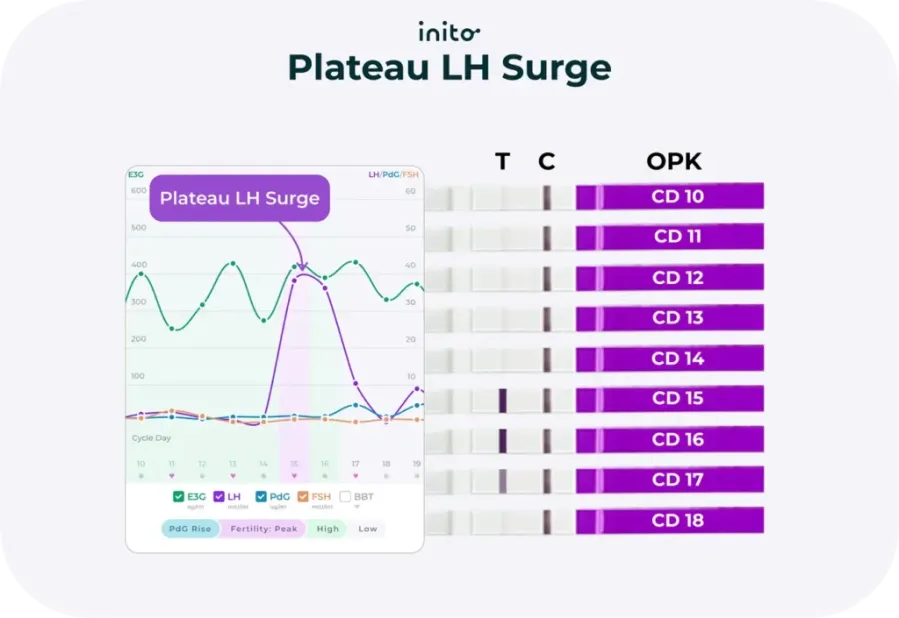
In a plateau surge, LH levels gradually rise and remain high for a few days before returning to normal. About 11% of LH surges follow this pattern.
OPK:
If you use an ovulation test with a plateau surge, the test line will be negative on the days before your LH surge.
Once the LH surge hits, you’ll get a positive result each day your LH levels are high. You can see this in the example above on cycle days 15 and 16. As your LH drops, the test line on your OPK will get fainter.
Inito:
Inito shows your exact LH levels so you can see your surge in action. As shown in the above image, LH stayed high on days 15 and 16 before falling on day 17.
Double surge
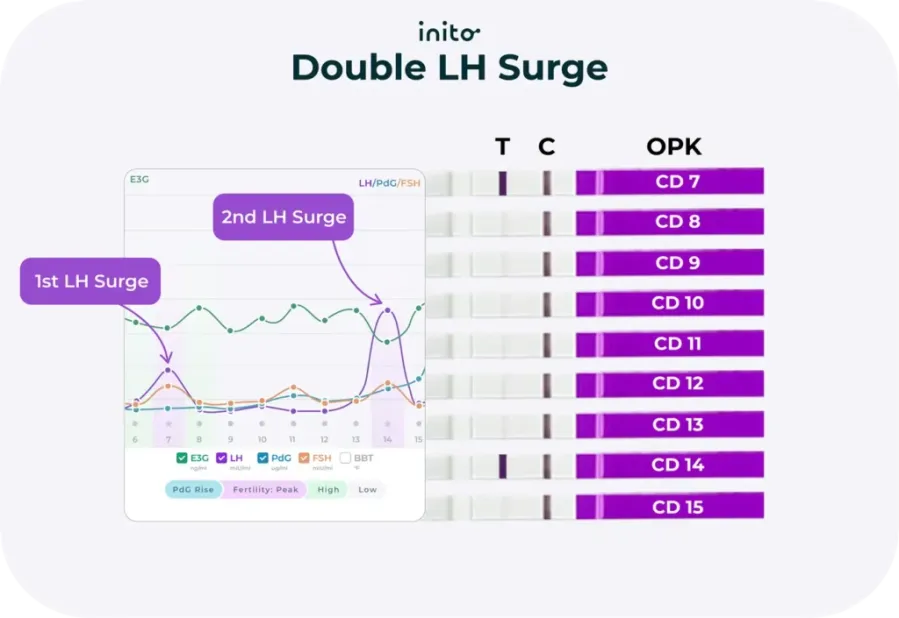
A double LH surge is when LH peaks twice within the same cycle. This happens in roughly 33% of cycles.
In this case, LH will spike, then decrease for a few days, and spike again. But the last LH peak is what triggers ovulation.
OPK:
On an OPK, you get a positive result each time your LH crosses the threshold. For example, the results above show a positive ovulation strip on cycle days 7 and 14.
On the days leading up to the two positive tests and the days between them, you’d get faint lines. Once LH levels fall after the second peak, the test line will also start to fade.
Inito:
Inito creates personalized hormone charts so you can better understand your surge pattern. Most people using OPKs stop testing as soon as they get a positive result. This can cause you to miss your second surge–and peak fertility that cycle.
Inito tells you to keep testing until the second peak hits. A rise in PdG can then confirm your true surge.
Biphasic surge
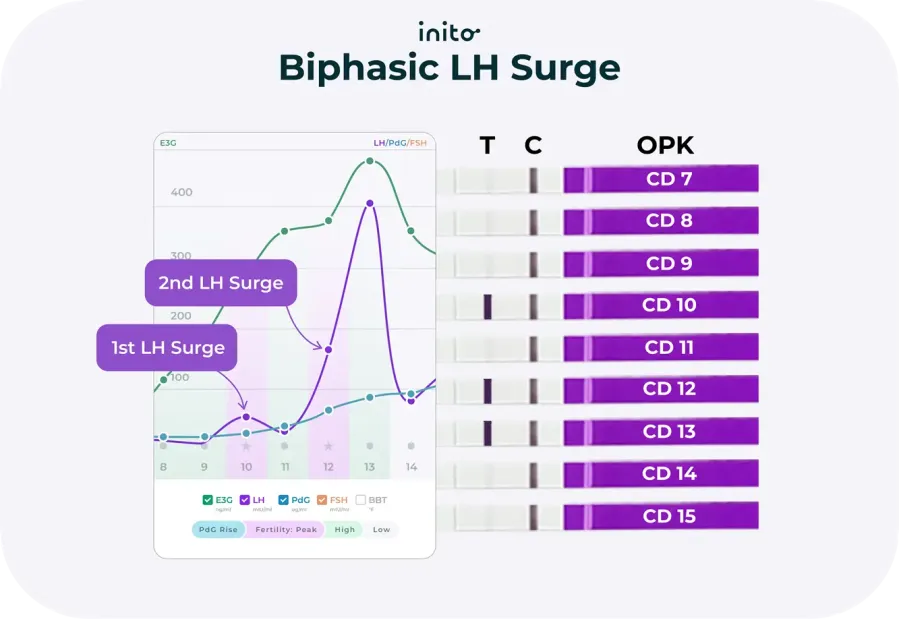
Biphasic LH surges are similar to double surges. The main difference is the period between the spikes. In this surge pattern, LH rises, drops for a day, and then immediately rises the day after.
OPK:
On OPKs, you’d see a positive result on both days when LH peaked. In the example above, this happened on cycle days 10 and 12, with LH remaining high on cycle day 13 as well. On the day between the two spikes, the test line may look faint–or not be visible at all.
Inito:
Inito shows two LH spikes on an easy-to-read chart. The app learns your unique surge patterns to make tracking ovulation easy.
Multiple surges
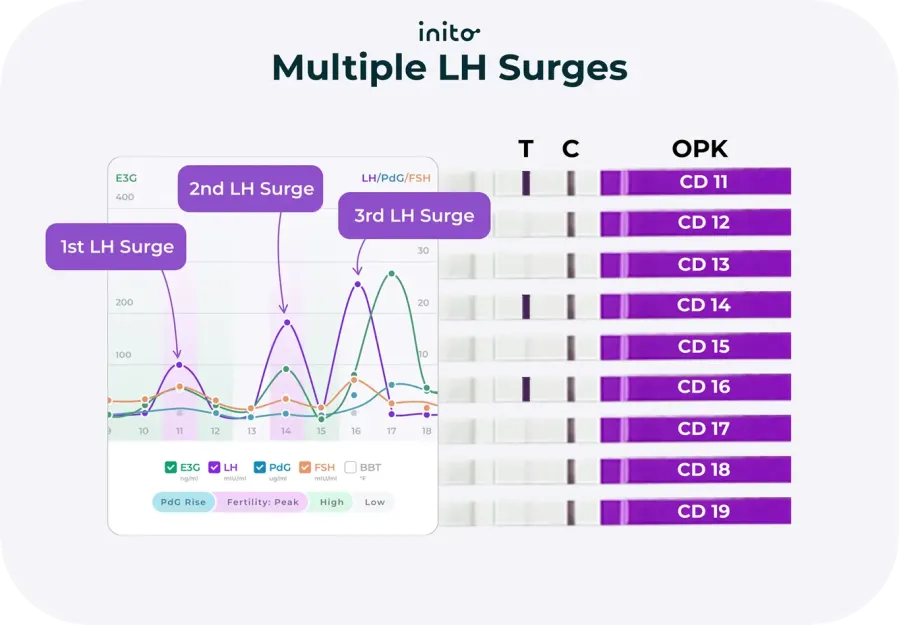
A multiple LH surge is when LH spikes more than two times. Of all surge patterns, this one is the rarest. It happens in about 8% of cycles.
OPK:
An OPK shows a positive result each time LH crosses the test’s threshold. In the example below, LH spiked on cycle days 11, 14, and 16–so you’d get a positive test on those days.
On the days LH stays below the threshold, you’d get either a faint positive or a negative. As you can imagine, this can get confusing!
Inito:
Inito bases results on your actual hormone values–not thresholds. You get clear results that show when you’re at peak fertility, so there’s zero guesswork.

See how your hormone chart might look like!
Answer some questions to help us provide you a free personalized hormone chart customized to your hormonal health and conditions
Photos of OPK progression
If you’re curious about what ovulation test progression looks like, here’s what users in our community had to share:
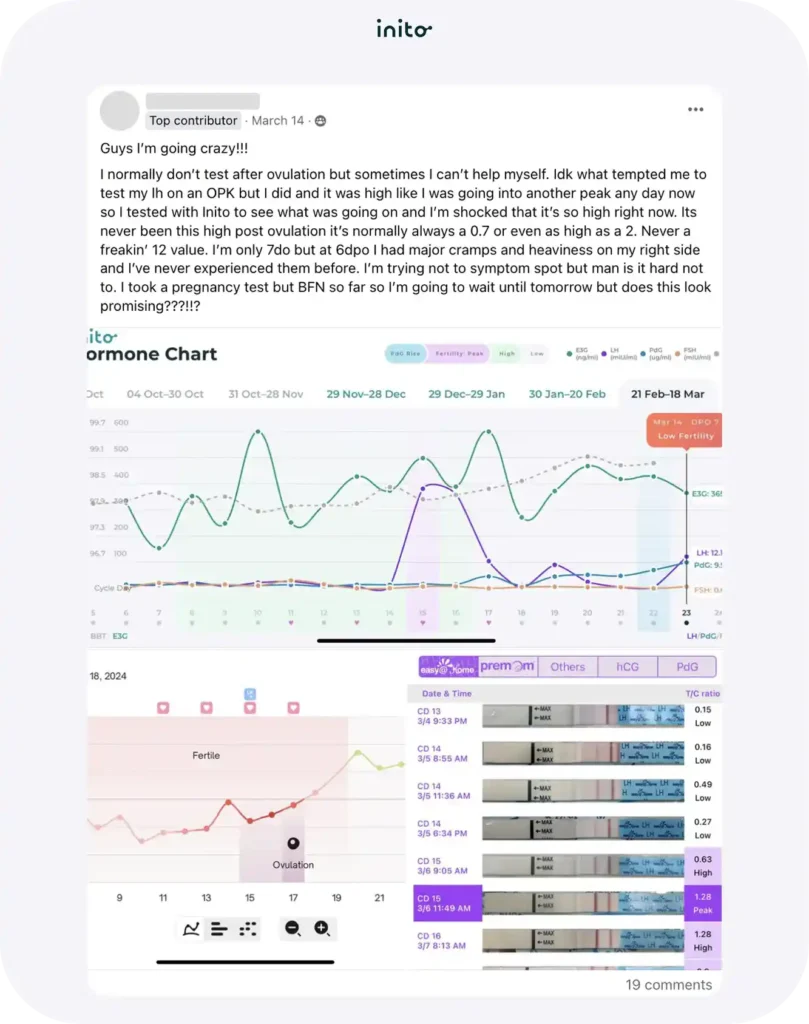
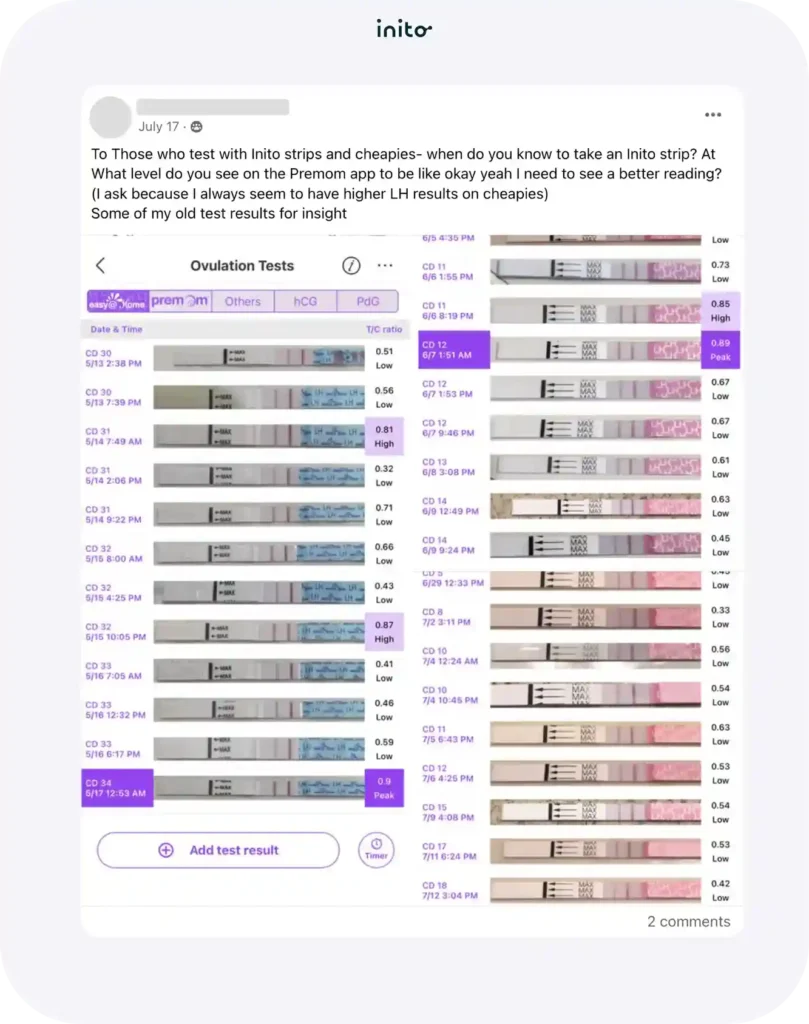
Why is my line not progressing?
If your ovulation tests don’t progress as expected, try not to worry. Several things can interfere with getting a positive result:
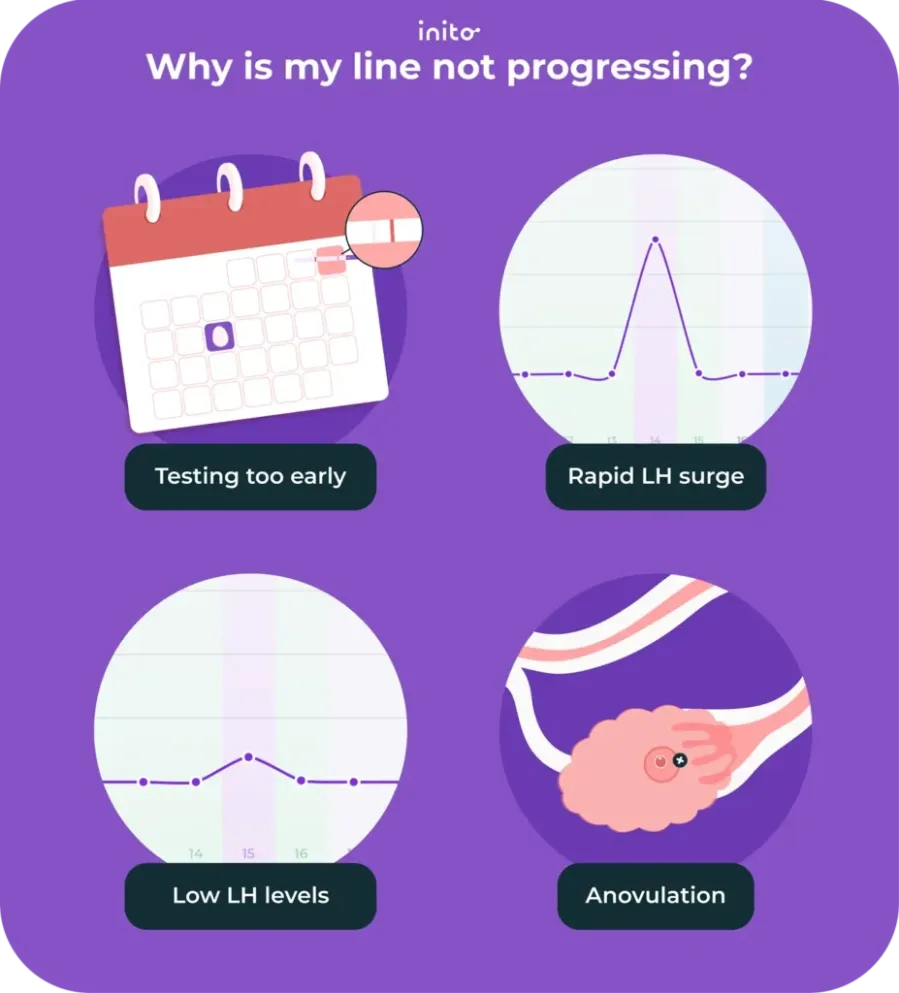
- Testing too early. You may have simply tested too early. Hang in there and keep testing every day until you get a positive test.
- Rapid surge. If your LH rises rapidly in less than a day, you could miss the surge. Try testing twice a day so you don’t miss it next cycle.
- Low LH levels. As mentioned, most ovulation predictor kits base their results on average thresholds. If your LH levels fall below the threshold, you’ll get a false negative. To avoid this, try using an ovulation test that measures your actual hormone values, like Inito.
- Anovulation. It’s possible you skipped ovulation that cycle. This is known as anovulation–and it happens in roughly one-third of all menstrual cycles. While it’s normal now and then, if it occurs often, it’s best to consult your doctor.
Learn more: Anovulation: Everything You Need to Know
When is the best time to start testing with OPKs?
It’ll vary depending on your cycle length and how regular they are.
Ovulation typically happens about 12-14 days before your next period. So, if you have a regular 28-day cycle, you would ovulate around day 14.
However, you’d want to start testing 4 days before your expected ovulation day. This means you’d begin testing on cycle day 10. That way, you don’t miss it.
It’s harder to predict ovulation days with irregular cycles. If you have irregular cycles, pick the shortest cycle length you’ve had in the past 6 months as a guide.
For example, if your shortest cycle length was 25 days, subtract 14 days to get an idea of when you ovulated (day 11). Start testing 4 days before this (day 7) for each cycle.
Ovulation days may vary from cycle to cycle. But it’s best to err on the safe side and test more days. That way, you don’t miss your fertile days that cycle.
When should I have sex after a positive test?
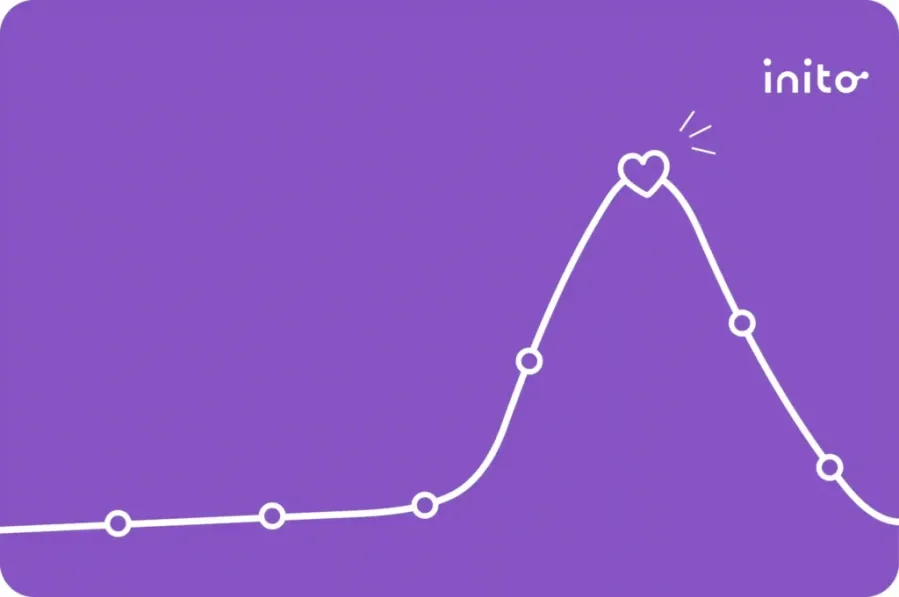
In a word–soon!
If you’re trying to conceive, you’ll want to have sex that day and each day you get a positive result. Remember–you’re at peak fertility when your LH surges. So now’s the time to get frisky.
To up your odds of getting pregnant, it’s best to make the most of your full fertile window. This includes the 4 days leading up to ovulation, your ovulation day, and the day after ovulation.
Try to have sex everyday or every other day during your fertile window. That way, you’ll have the best chances of conception.
You can use Inito to pinpoint all your fertile days. Inito measures four hormones: LH, estrogen, PdG (a urine metabolite of progesterone), and FSH.
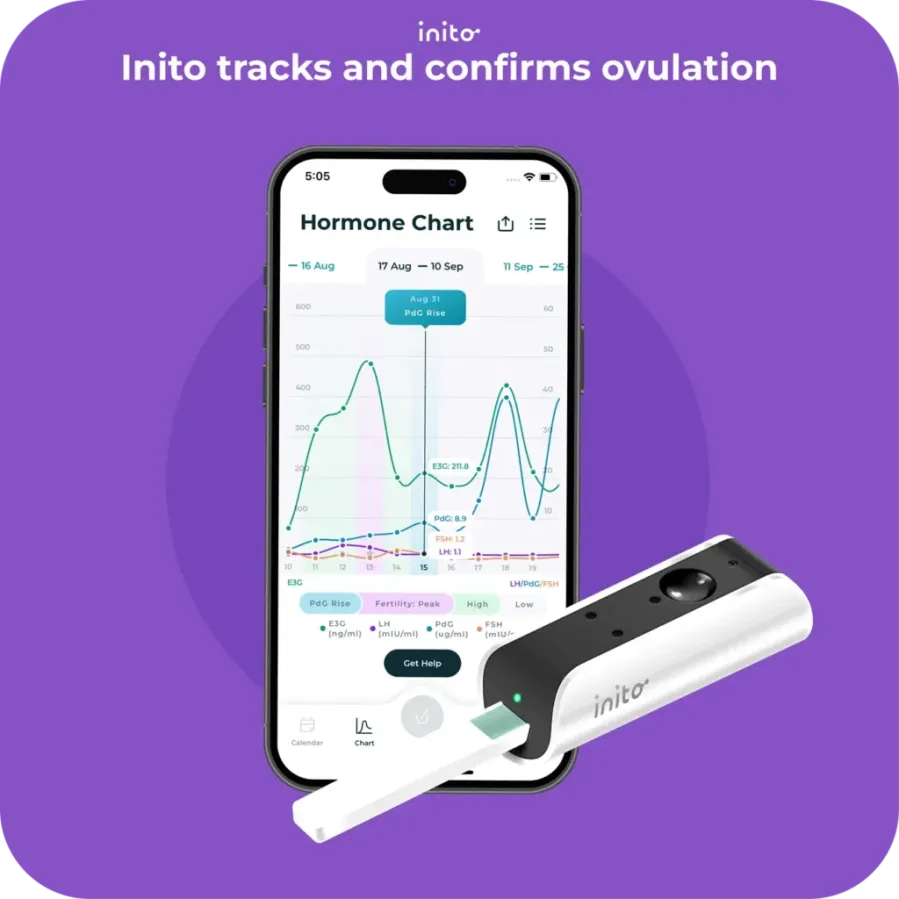
Estrogen starts rising 4-5 days before ovulation. When estrogen increases, it’s a sign you’ve entered your fertile window. LH then marks peak fertility. And a rise in PdG confirms that an egg was released.
This means Inito can help you track ovulation and confirm it happened.
Know more: Is Having Sex Everyday Bad When Trying to Conceive?

FAQs
Roughly 1-2 days. The day after ovulation marks the end of your fertile window. And as mentioned, LH surges 24-36 hours before you ovulate.
Your LH levels may simply be higher than the OPK’s threshold. Or you may have a gradual LH surge. Sometimes, it may also be a sign of polycystic ovary syndrome (PCOS). Women with PCOS tend to have high LH levels throughout their cycle. You can learn more about PCOS here.
First, let’s clear up what a T/C ratio is. The T/C ratio compares how dark the test line (T) is compared to the control line (C). Most ovulation tests give a positive result when the T/C ratio is 1.0 or above. That’s a fancy way of saying that the test line should be as dark or darker than the control line.
Was this article helpful?
- Physiology, Luteinizing Hormone – StatPearls – NCBI Bookshelf
- Findings from a mobile application–based cohort are consistent with established knowledge of the menstrual cycle, fertile window, and conception
- Relationships between the luteinizing hormone surge and other characteristics of the menstrual cycle in normally ovulating women – Fertility and Sterility
- Ovulation Prevalence in Women with Spontaneous Normal-Length Menstrual Cycles – A Population-Based Cohort from HUNT3, Norway – PMC
- Detection of ovulation, a review of currently available methods – PMC




